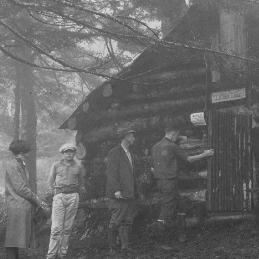Browse
"Exposure of U.S. National Parks to Land Use and Climate Change 1900-2100 ." Ecological Applications 24, no. 3 (2014): 484-502.
"Fleshy Saprobic and Ectomycorrhizal Fungal Communities Associated with Healthy and Declining Eastern Hemlock Stands in Great Smoky Mountains National Park." Southeastern Naturalist 13, no. 6 (2014): 192-218.
"A Molecular Clone and Culture Inventory of the Root Fungal Community Associated with Eastern Hemlock in Great Smoky Mountains National Park." Southeastern Naturalist 13, no. 6 (2014): 219-237.
"A Molecular Clone and Culture Inventory of the Root Fungal Community Associated with Eastern Hemlock in Great Smoky Mountains National Park." Southeastern Naturalist 13, no. 6 (2014): 219-237.
"Rhododendron Decline in the Great Smoky Mountains and Surrounding Areas." Southeastern Naturalist 13, no. 1 (2014): 1-25.
"Spatial Distribution of Hemlock Woolly Adelgid Induced Hemlock Mortality in the Southern Appalachians." Open Journal of Forestry 4, no. 5 (2014): 492-506.
"Summer Habitat Use and Partitioning by Two Reintroduced Rare Madtom Species." Journal of Freshwater Ecology 29, no. 2 (2014): 243-258.
"All Taxa Biodiversity Inventory Survey of Select Soil and Plant Ecological Parameters Associated with Rhododendron Decline in the Great Smoky Mountains and Surrounding Area." Southeastern Naturalist 12, no. 4 (2013): 703-722.
"Arthopyrenia Betulicola (Arthopyreniaceae, Dothidiomycetes), an Unusual New Lichenized Fungus From High Elevations of the Southern Appalachian Mountains." Aliso: A Journal of Systematic and Evolutionary Botany 31, no. 2 (2013): 77-81.
"Database of the Smokies." Choice: Current Reviews for Academic Libraries 50, no. 10 (2013): 1793.
"Evolutionary Consequences of Putative Intra- and Interspecific Hybridization in Agaric Fungi." Mycologia 105, no. 6 (2013): 1577-1594.
"Factors Affecting Establishment and Recovery of Sasajiscymnus tsugae (Coleoptera: Coccinellidae), an Introduced Predator of Hemlock Woolly Adelgid (Hemiptera: Adelgidae) on Eastern Hemlock (Pinales: Pinaceae)." Environmental Entomology 42, no. 6 (2013): 1123-1453.
"Failed Species, Innominate Forms, and the Vain Search for Species Limits: Cryptic Diversity in Dusky Salamanders (Desmognathus) of Eastern Tennessee." Ecology and Evolution (2013).
Great Smoky Mountains National Park tourism creates $818 million in local economic benefit. Vol. 2013. Newport, TN: The Newport Plain Talk, 2013.
An Indexed Reference Database of the Great Smoky Mountains, North Carolina and Tennessee. Knonxville, TN: National Park Service-Cooperative Park Studies Unit, Dept. of Forestry, Wildlife and Fisheries, University of Tennessee, 2013.
The Lichens and Allied Fungi of Great Smoky Mountains National Park: An Annotated Checklist with Comprehensive Keys In Memoirs of the New York Botanical Garden. New York Botanical Garden Press, 2013.
Plant Guide for Southeastern Wildrye ( Elymus glabriflorus ) In Plant Guides. Vol. 2014. Natural Resources Conservation Service, 2013.
A Qualitative Study of the Great Smoky Mountain Institute at Tremont's Citizen Science Youth Internship Program In Biology. Vol. Master of Science. Middle Tennessee State University, 2013.
"Rhododendron Decline in the Great Smoky Mountains and Surrounding Areas." Southeastern Naturalist 12, no. 4 (2013): 703-722.
Along the Appalachian Trail: Georgia, North Carolina, and Tennessee In Images of America. Charleston, SC: Arcadia Publishing, 2012.
"Ambient Ozone Effects on Gas Exchange and Total Non-Structural Carbohydrate Levels in Cutleaf Coneflower (Rudbeckia laciniata L.) Growing in Great Smoky Mountains National Park." Environmental Pollution 160, no. January (2012): 74-81.
"Arriving at Pittman Center." Smoky Mountain Historical Society Journal and Newsletter 38, no. 2 (2012): 19.
"Contribution of Organosulfur Compounds to Organic Aerosol Mass." Environmental Science & Technology 46, no. 15 (2012): 7978-7983.
"Contribution of Organosulfur Compounds to Organic Aerosol Mass." Environmental Science & Technology 46, no. 15 (2012): 7978-7983.
















































